|
|
ARTHROPODS:
Insects»
Spiders»
Centipedes»
Millipedes»
Sowbugs»
Harvestmen»
Mites
& Ticks»
Scorpions»
Identification
Tips»
About
the Critter Files»
Links» |
|
|
|
 |
JUMPING
SPIDERS
Critter
Files/Spiders/Jumping Spiders
By Blake Newton
University of Kentucky Department of Entomology |
| |
|
| Among Kentucky spiders,
Jumping Spiders may be the easiest to recognize.
Jumping spiders have a very distinctive, flat-faced, big-eyed
appearance that is difficult to confuse with other kinds of spiders.
They also have a unique, herky-jerky way of moving. Most
are small and hairy. Like all spiders, jumping spiders have
8 legs, 2 body parts, and no antennae. Eight eyes are present
on jumping spiders, although 1 pair is often so small that it appears
as though there are only 6 eyes. One pair of eyes is always
very large and directed forward, almost like human eyes. |
|
| SIZE:
Body length up to about 1/2" |
| |
| LIFE
CYCLE |
|
Simple
metamorphosis: like all spiders, young jumping spiders hatch from
eggs and look like tiny adults. They shed their skin as they
grow. Many female jumping spiders construct a silk case for
their eggs and guard them until they hatch. The egg case is
often built off of the ground in leaves, on branches, or in crevices
on the sides of buildings.
|
| |

Female jumping spider guarding
eggsac (B. Newton, 2004) |
| |
| ECOLOGY |
|
|
Jumping spiders are
fast-moving, active hunters. Because they are excellent climbers
and jumpers, they are able to search for prey in many different
locations. Some hunt on the ground, while others search tree
trunks and plants for prey. Many are also common on man-made
structures like fence posts and the sides of buildings. Jumping
spiders are also common inside barns and sheds.
|
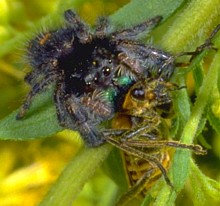
Jumping spider attacking soldier beetle.
(R. Bessin, 2001) |
| |
| Jumping spiders
are among the fastest creatures in the arthropod world. Their
speed and keen eyesight allow them to pounce on flies, crickets, and
even other spiders with amazing accuracy. Many species of jumping
spiders have colors that allow them to blend in with their surroundings.
This makes it easier for them to stalk prey, and also helps
them to avoid being eaten by birds, wasps, and other predators. |
| |
| PEST
STATUS |
|
Jumping
spiders are not normally pests, but they often wander into homes.
They can bite, but they are not considered dangerous. Because
they sometimes get into homes, jumping spiders are occasionally
confused with the dangerous brown recluse spider. Take a look
at the Case File for Brown
Recluse Spiders, and our Brown
Recluse ENTfact to learn how to identify Brown Recluse spiders. |
| |
| COMMON
KENTUCKY JUMPING SPIDERS |
|
There are
many different species of jumping spiders in Kentucky. Most
of them are similar in size and shape, but there are many different
colors and patterns among jumping spiders. Although we can't
show them all here, we will try to spotlight some of the most common
and most colorful. Thanks to Wayne Maddison from the University
of British Columbia for help with identification of some of the jumping
spiders pictured below. To learn more about jumping spiders,
visit Wayne's Salticidae section of the Tree of Life web project at:
http://tolweb.org/tree?group=Salticidae |
|
|
Phidippus
sp.
GENUS: Phidippus
Jumping spiders in the
Phidippus genus are some of the largest
in the family. Many species are black with red or white markings,
and some have metallic green chelicerae. Below left is a typical
Phidippus species. The Bold Jumping Spider,
Phidippus audax, (below right) also called the "Daring
Jumping Spider" and the "Bold Jumper," is one of
the largest jumping spiders found in Kentucky
(1/2"). It is also one of the most commonly seen jumping
spiders, and is often found hunting around homes and barns and on
fences. This spider is large enough to bite, but its bite
is not dangerous except to people with severe allergies. This
spider is easy to recognize by its large size and metallic green
chelicerae. The bold jumping spider is shown feeding on a
beetle above in the Ecology section. Shown
below (center) is a female Phidippus whitmani. P. whitmani is another large (1/2") jumping
spider. While the female is tan with white markings, the male
looks very different, with grey legs and an orange/red abdomen and
thorax. |
| |
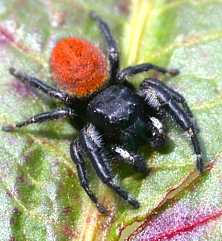 Phidippus
sp. (B. Newton, 2005)
Phidippus
sp. (B. Newton, 2005) |
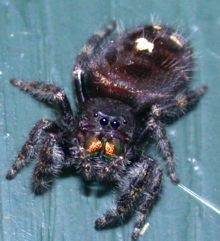 Bold
Jumping Spider, Phidippus audax (B. Newton, 2004)
Bold
Jumping Spider, Phidippus audax (B. Newton, 2004) |
| |
|
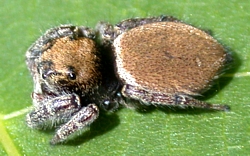 Phidippus
whitmani, female (B. Newton, 2004)
Phidippus
whitmani, female (B. Newton, 2004) |
|
|
|
Platycryptus
GENUS: Platycryptus
Typical jumping spiders
in the genus Platycryptus are gray with
black markings. Pictured below is a female Platycryptus
undatus. It was about 1/2" long and is common in
Kentucky. |
| |
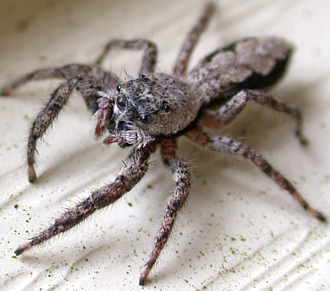 Platycryptus
undatus, female (B. Newton, 2004)
Platycryptus
undatus, female (B. Newton, 2004)
|
|
|
|
DIMORPHIC
JUMPING SPIDER
GENUS and SPECIES:
Maevia inclemens
The Dimorphic
Jumping Spider, Maevia inclemens, is so-called
because males of the species come in two forms: one form looks like
the one pictured below left, and the other form resembles a thinner
version of the female, below right. These jumping spiders
are common in urban areas and meadows, and are about 1/4". |
| |
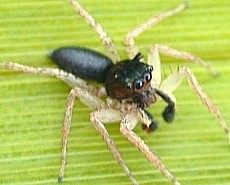 Male
dimorphic jumping spider (B. Newton, 2004)
Male
dimorphic jumping spider (B. Newton, 2004) |
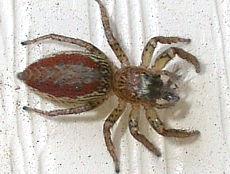 Female
dimorphic jumping spider (B. Newton, 2004)
Female
dimorphic jumping spider (B. Newton, 2004)
|
|
|
|
Paraphidippus
aurantius
GENUS and SPECIES:
Paraphidippus
aurantius
Pictured below is Paraphidippus
aurantius. This distinct jumping spider
is about 3/8". |
| |
 Paraphidippus
aurantius (B. Newton, 2006)
Paraphidippus
aurantius (B. Newton, 2006)
|
|
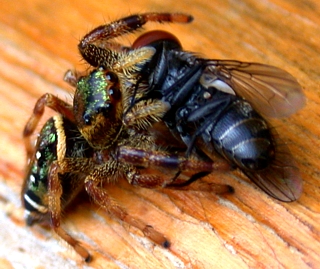 Paraphidippus
aurantius feeding on a fly (B. Newton, 2006)
Paraphidippus
aurantius feeding on a fly (B. Newton, 2006)
|
|
|
|
HENTZIA
sp.
GENUS: Hentzia
Shown below is a male
Hentzia mitrata, photographed in Bullitt Co. Kentucky.
Male jumping spiders in the Hentzia genus have very
large chelicerae.
|
| |
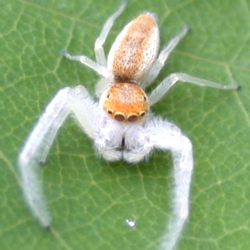 Hentzia
mitrata (B. Newton, 2004)
Hentzia
mitrata (B. Newton, 2004) |
|
|
|
ANT-MIMIC
JUMPING SPIDERS
GENUS: Tutelina,
others
There are several species
of jumping spiders that resemble ants. Most of these spiders
also feed on ants: by mimicking ants - in both behavior and appearance
- these jumping spiders can "infiltrate" a group of ants
and pick them off one by one because ants have trouble identifying
these spiders as predators. Tutelina
formicaria, shown below, was photographed in
Rowan Co. Kentucky. It can be found among ants in woodland settings. Sometimes, before capturing
its prey, this spider seems to interact with an ant: the spider
touches its front legs against the ants antennae, much in the same
way that two ants will communicate with each other. Perhaps
this behavior is part of the mimicry that these spiders employ to
confuse and capture ants. |
| |
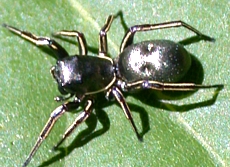 Tutelina
formicaria
Tutelina
formicaria
(B. Newton, 2004) |
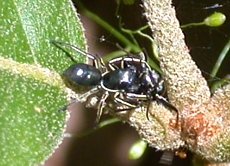 Tutelina
formicaria,
feeding on an ant
Tutelina
formicaria,
feeding on an ant
(B. Newton, 2004) |
|
| |
| COLLECTING
& PHOTOGRAPHY |
|
Jumping spiders are
very common around buildings, gardens, homes, and most other places
as well. Although jumping spiders are easy to find, they can
be hard to catch - as soon as you think you have one cornered, it
has jumped away. As with all spiders, never pick up a jumping
spider with your bare hands.Use a jar or a similar container.
Taking pictures of jumping
spiders is also difficult because the spiders do not stand still
for very long. Make sure you have a lot of light and a fast
film speed when trying to take close-up pictures of jumping spiders.
|
| |
| JUMPING
SPIDER FACTS |
|
Jumping spiders are
believed to have the best eyesight of all spiders, maybe of all
arthropods.
Jumping spiders do not
build a web to catch prey. Instead, they use their silk in
a different way. When jumping spiders jump, they always attach
a silk line. That way, if they miss their target they they
can climb back up and try the jump again.
|
| |
| JUMPING
SPIDER LINKS |
|
Because jumping spiders
are so fascinating, there are many webpages devoted to them. Here
are some of the best.
Wayne Maddison, a scientist
who does research with jumping spiders, has put together a fantastic
web page all about jumping spiders. Click here
to access his jumping spider section on the Tree
of Life web project. You'll find pictures of many species, in-depth
discussions of jumping spider eyesight and courtship, and technical
information on how to identify jumping spiders.
Also, be sure to see
the page on Australian
jumping spiders by Ed Nieuwenhuys. He has many other kinds
of spiders featured on his website, too.
Visit the Jumping Spider Section of Bugguide for more common North American jumping spiders. |
| |
| MYTHS
- LEGENDS - FOLKLORE |
|
Do you know any myths,
legends, or folklore about jumping spiders? If so, let us know.
|
Original document: 25 May 2004
Last updated: 7 Feb 2008
Photos courtesy R.
Bessin and B. Newton, University of Kentucky
The Kentucky Critter Files are maintained
by Blake Newton, Department of Entomology, University of Kentucky.
Contact: blaken@uky.edu |
|

